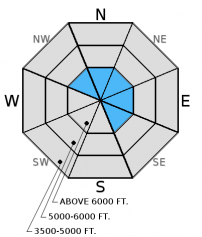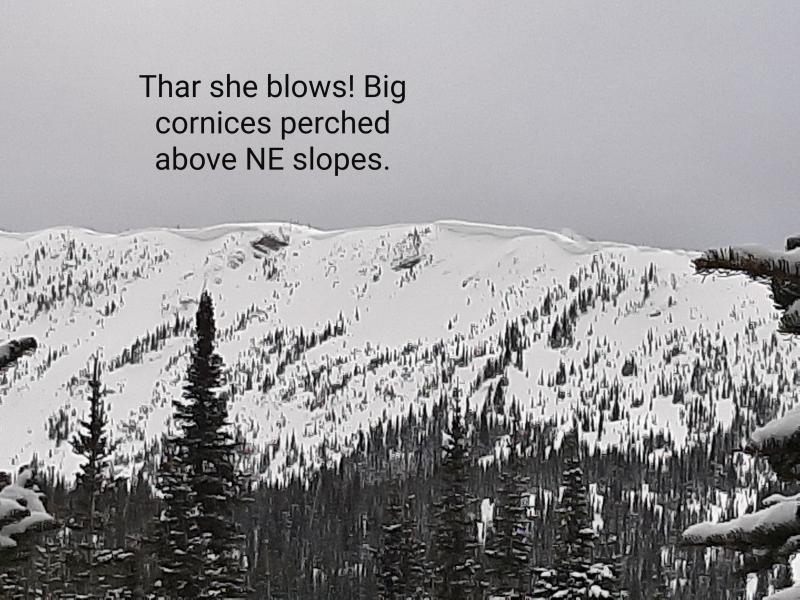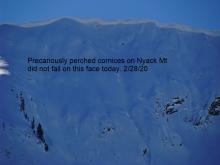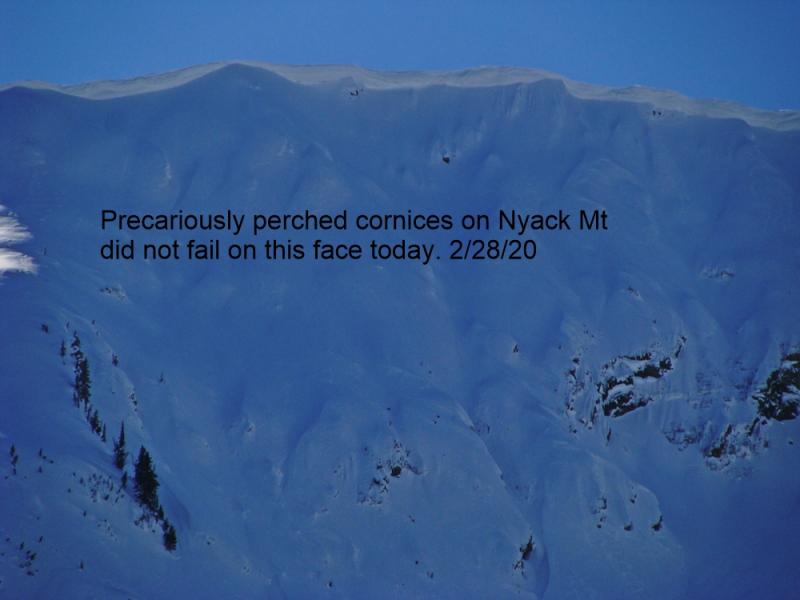| Sunday | Sunday Night | Monday | |
|---|---|---|---|
| Cloud Cover: | Partly cloudy and warm. | Partly cloudy. | Cooler temperatures, showers, and increased wind. |
| Temperatures: | 48-60 deg. F. | 32-38 deg. F. | 41-52 deg. F. |
| Wind Direction: | SW | SW | S-SW |
| Wind Speed: | 5-8 gusts 18 | 5 | 11-13 gusts 32-43 |
| Snowfall: | 0 in. | 0 in. | 0 in. |
| Snow Line: |
Whitefish Range
Swan Range
Flathead Range and Glacier National Park
How to read the forecast
Dangerous conditions due to wet avalanches, cornice fall, and lingering windslabs will persist until there is a solid re-freeze. Warm temperatures and periods of intense sunshine produced many natural avalanches over the past 48 hours. The avalanche danger is CONSIDERABLE. The likelihood of both human triggered and natural avalanches will rise as the day progresses so choose conservative terrain to ski and ride in.

3. Considerable
?
Above 6500 ft.
3. Considerable
?
5000-6500 ft.
3. Considerable
?
3500-5000 ft.
- 1. Low
- 2. Moderate
- 3. Considerable
- 4. High
- 5. Extreme
-
Type ?
-
Aspect/Elevation ?

-
Likelihood ?CertainVery LikelyLikelyPossible
 Unlikely
Unlikely -
Size ?HistoricVery LargeLargeSmall

Most mountain locations have not seen a solid refreeze in the past 48 hours which gives the continued warm temperatures and sunshine an early start at weakening the surface snow. We observed widespread loose, wet avalanches over the past few days. The largest of these were on sunny slopes, but they occurred on shaded slopes as well and will likely be able to entrain more wet snow today as these balmy temperatures persist. The first signs of wet snow instability are rollerballs and pinwheels developing on a slope. When the snow surface becomes moist make conservative terrain choices like avoiding run-out zones and sticking to lower angle slopes.
An additional concern following another warm night is the continued melt water moving through the snowpack. When this melt-water pools on a crust and weakens the bond with the overlying slab we can start to see wet slab avalanches release. Most accidents involving wet slabs are from natural avalanches so the best way to manage this problem is by choosing conservative terrain until we see cooler temperatures.
-
Type ?
-
Aspect/Elevation ?

-
Likelihood ?CertainVery LikelyLikelyPossible
 Unlikely
Unlikely -
Size ?HistoricVery LargeLargeSmall

Warm temperatures and periods of sunshine weakened the large, abundant cornices in the area (photo). Friday, a cornice fall on Nyack Mountain in the Flathead Range triggered a deeper slab and the resulted in a very large avalanche (observation). Yesterday, on a smaller scale, we witnessed another cornice fall triggered slab avalanche in the Swan Range (observation and video). Aside from the overhead danger of these giant blocks of snow, they are capable of triggering deep weak layers that would otherwise remain dormant in the snowpack. Cornices can pull far back from behind the ridge line making it important to keep an exaggerated distance away from the edge when traveling above cornices. Even small, scrubby trees are not an adequate indication that you are far enough back.
Also, we observed glide cracks on numerous slopes throughout the advisory area (image) and several have even failed. Whitefish Mountain Resort Ski Patrol reported widening glide cracks on Thursday. Glide avalanches are very difficult to predict, so the best strategy is to avoid playing on slopes where glide cracks exist. Today's continued above normal temperatures and sunshine could cause glide cracks to release as avalanches.
-
Type ?
-
Aspect/Elevation ?

-
Likelihood ?CertainVery LikelyLikelyPossible
 Unlikely
Unlikely -
Size ?HistoricVery LargeLargeSmall

Several generations of wind slabs formed last week on multiple aspects. These slabs are not presenting obvious signs of instability and most recent observations suggest that they have strengthened. However, large triggers over the past few days in the form of cornice fall produced a few large avalanches, and warm temperatures may continue to weaken them. Above freezing temperatures and additional sunshine could make wind slabs more sensitive to human triggering today.
Additional concern: You may find weak snow surrounding a series of melt-freeze and rain crusts from late February and March located 1.5 to 3 feet from the surface. These layers have not produced recent avalanches. However, digging into the snow and performing stability tests is the only way to determine if deeper weak layers exist.
Saturday: We were in the Lost Johnny Drainage in the Swan Range. Temperatures warmed early in the day to the low-40s. We observed widespread natural loose, wet activity on all aspects and large cornices. In the afternoon, we witnessed a slab avalanche triggered by cornice fall above Lamoose Lake at the head of the drainage (observation, video). On a south facing slope near 7000 feet we found a shallow snowpack that was moist throughout (photo). There was a prominent crust about 18 inches from the surface that had pooled water above the crust. Skiers on Huckleberry Ridge in Glacier National Park found a variety of crusts in the upper snowpack and stability tests produced fractures nearly a foot from the surface. They noted thick, older windslabs that were minimally reactive in stability tests but produced clean shears (observation).
Friday: Skiers in the Cascadilla Drainage in the Flathead Range reported a large natural avalanche thought to have been triggered by cornice fall (observation). Skiers outside of the advisory in the St. Mary area of Glacier National Park reported multiple natural, loose, wet avalanches on sun exposed slopes that began at about 10:30 am.
Thursday: A skier on Glacier View Mountain in the Whitefish Range intentionally triggered a wet, loose avalanche on a north aspect at 5400 feet (observation). Whitefish Mountain Resort Ski Patrol reported skier triggered loose, wet avalanche (photo) and widening glide cracks. Erich and I observed a softening snow surface on most aspects despite cloud cover in China Basin and Werner Peak in the Whitefish Range yesterday. We did not observe any avalanche activity by mid to late afternoon (observation).
Visit our Observations page and our You Tube channel for more observations from the entire season.
Thanks to everyone for submitting observations. They are extremely useful and could help save lives.
HOW TO SUBMIT OBSERVATIONS:
Email: [email protected]
Call and leave a message: 406.387.3821
You can also submit quick observations via text: 406.241.4571 (FAC mobile)
OR
Submit Snowpack Observations: http://www.flatheadavalanche.org/node/add/snowobs
Submit Avalanche Observations: http://www.flatheadavalanche.org/node/add/avyobs
Yesterday the ridge of high pressure that moved into the area brought another warm day to the region. Clouds rolled in mid-day and kept temperatures from climbing much higher than on Friday. This morning temperatures above 6000 feet range from 36º-40º F, and winds are blowing out of the southwest at 6-14 mph with gusts from 14-26 mph. Today, should see partly cloudy skies with temperatures climbing back to the upper-40s to low-50s. Winds will remain out of the southwest at 5-15 mph.
| 0600 temperature: | 36-40 deg. F. |
| Max. temperature in the last 24 hours: | 48-53 deg. F. |
| Average wind direction during the last 24 hours: | SW |
| Average wind speed during the last 24 hours: | 10-25 mph |
| Maximum wind gust in the last 24 hours: | 29-42 mph |
| New snowfall in the last 24 hours: | 0 inches |
| Total snow depth: | 78-114 inches |
This advisory applies only to backcountry areas outside established ski area boundaries. This advisory describes general avalanche conditions and local variations always occur. This advisory expires at midnight on the posted day unless otherwise noted. The information in this advisory is provided by the USDA Forest Service who is solely responsible for its content.






































